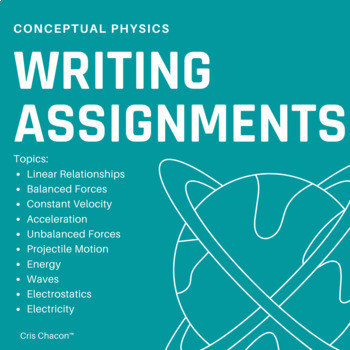01 - Scientific Thinking Writing Assignment
Conceptual Physics
171 Followers
Grade Levels
7th - 12th
Subjects
Resource Type
Standards
CCSS8.F.A.3
CCSS8.F.B.4
CCSS8.F.B.5
CCSSHSN-Q.A.1
CCSSHSN-Q.A.2
Formats Included
- Google Docs™
Pages
1 page
Conceptual Physics
171 Followers

Made for Google Drive™
This resource can be used by students on Google Drive or Google Classroom. To access this resource, you’ll need to allow TPT to add it to your Google Drive. See our FAQ and Privacy Policy for more information.
Also included in
- 9 fully editable, NGSS/modeling pedagogy aligned short writing assignments! These short writing assignments are usually one page long and include 3-4 short answer prompts that require students to explain and demonstrate their mastery of different learning targets covered in each unit. There is a rubPrice $27.00Original Price $30.00Save $3.00
- 21 fully editable, NGSS/modeling pedagogy aligned quizzes, 9 unit tests, 10 writing assignments, and 2 final exams!QuizzesThere are a mix of free-response and multiple-choice questions for most quizzes, which are usually one or two pages long. Quizzes are used for students to demonstrate proficiencyPrice $225.00Original Price $268.00Save $43.00
- *You can request sample previews of resources or units! Please email cris.chacon@knowlesteachers.org to request them. Additionally, upon purchase, please email cris.chacon@knowlesteachers.org to receive immediate access to all of these resources and more through Google Drive Folders and Documents.43Price $675.00Original Price $841.00Save $166.00
- 3 fully editable, NGSS/modeling pedagogy aligned worksheets, 4 inquiry labs, 3 lab challenges, 2 quizzes, 6 guided notes/reading assignments, 1 unit review, 1 writing assignment, 1 equation toolbox, and 1 curriculum guide!WorksheetsThere are a variety of free response questions for most worksheets,Price $60.00Original Price $76.00Save $16.00
- 17 fully editable, NGSS/modeling pedagogy aligned worksheets, 9 quizzes, 16 inquiry labs, 4 unit reviews, 4 unit tests, 7 lab challenges, 5 writing assignments, 5 concept builders, 5 equation toolboxes, 15 guided readings and notes, and 5 curriculum guides!WorksheetsThere are a variety of free respoPrice $350.00Original Price $427.00Save $77.00
Description
Fully editable, NGSS/modeling pedagogy aligned short writing assignment! These short writing assignments are usually one page long and include 3-4 short answer prompts that require students to explain and demonstrate their mastery of different learning targets covered in each unit. There is a rubric embedded at the bottom of each assignment as well for streamlined grading.
Learning Targets Assessed:
I know...
- the definition of a dependent variable and an independent variable.
- the definition of a linear equation, slope, and y-intercept.
- how to collect valid and reliable data.
I can...
- plot data from a table on a graph, ensuring to label and scale axes appropriately.
- calculate the rate of change (slope) from a table or graph.
- identify the rate of change (slope) from a linear equation.
- identify the y-intercept in a linear equation.
- write a linear equation to model the relationship between two variables
- design and carry out an experiment.
- collect and analyze data.
Solutions are available by purchasing the Conceptual Physics Writing Assignments Bundle.
Total Pages
1 page
Answer Key
Not Included
Teaching Duration
N/A
Report this resource to TPT
Reported resources will be reviewed by our team. Report this resource to let us know if this resource violates TPT’s content guidelines.
Standards
to see state-specific standards (only available in the US).
CCSS8.F.A.3
Interpret the equation 𝘺 = 𝘮𝘹 + 𝘣 as defining a linear function, whose graph is a straight line; give examples of functions that are not linear. For example, the function 𝘈 = 𝑠² giving the area of a square as a function of its side length is not linear because its graph contains the points (1,1), (2,4) and (3,9), which are not on a straight line.
CCSS8.F.B.4
Construct a function to model a linear relationship between two quantities. Determine the rate of change and initial value of the function from a description of a relationship or from two (𝘹, 𝘺) values, including reading these from a table or from a graph. Interpret the rate of change and initial value of a linear function in terms of the situation it models, and in terms of its graph or a table of values.
CCSS8.F.B.5
Describe qualitatively the functional relationship between two quantities by analyzing a graph (e.g., where the function is increasing or decreasing, linear or nonlinear). Sketch a graph that exhibits the qualitative features of a function that has been described verbally.
CCSSHSN-Q.A.1
Use units as a way to understand problems and to guide the solution of multi-step problems; choose and interpret units consistently in formulas; choose and interpret the scale and the origin in graphs and data displays.
CCSSHSN-Q.A.2
Define appropriate quantities for the purpose of descriptive modeling.







